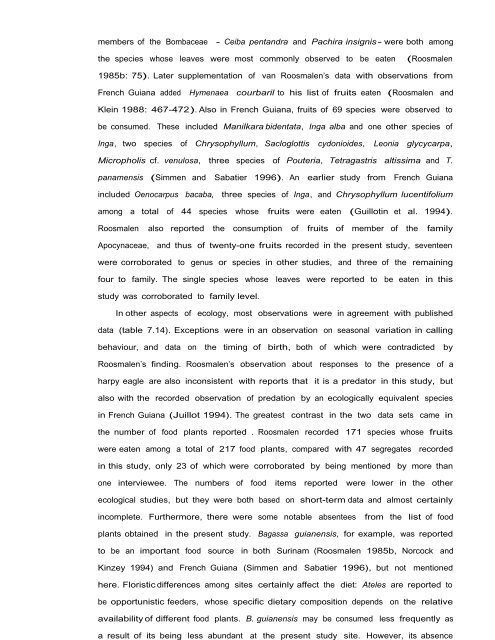Ethnoecology, Resource Use, Conservation And Development In A ...
Ethnoecology, Resource Use, Conservation And Development In A ...
Ethnoecology, Resource Use, Conservation And Development In A ...
You also want an ePaper? Increase the reach of your titles
YUMPU automatically turns print PDFs into web optimized ePapers that Google loves.
members of the Bombaceae - Ceiba pentandra and Pachira insignis - were both among<br />
the species whose leaves were most commonly observed to be eaten (Roosmalen<br />
1985b: 75). Later supplementation of van Roosmalen’s data with observations from<br />
French Guiana added Hymenaea courbaril to his list of fruits eaten (Roosmalen and<br />
Klein 1988: 467-472). Also in French Guiana, fruits of 69 species were observed to<br />
be consumed. These included Manilkara bidentata, <strong>In</strong>ga alba and one other species of<br />
<strong>In</strong>ga, two species of Chrysophyllum, Sacloglottis cydonioides, Leonia glycycarpa,<br />
Micropholis cf. venulosa, three species of Pouteria, Tetragastris altissima and T.<br />
panamensis (Simmen and Sabatier 1996). An earlier study from French Guiana<br />
included Oenocarpus bacaba, three species of <strong>In</strong>ga, and Chrysophyllum lucentifolium<br />
among a total of 44 species whose fruits were eaten (Guillotin et al. 1994).<br />
Roosmalen also reported the consumption of fruits of member of the family<br />
Apocynaceae, and thus of twenty-one fruits recorded in the present study, seventeen<br />
were corroborated to genus or species in other studies, and three of the remaining<br />
four to family. The single species whose leaves were reported to be eaten in this<br />
study was corroborated to family level.<br />
<strong>In</strong> other aspects of ecology, most observations were in agreement with published<br />
data (table 7.14). Exceptions were in an observation on seasonal variation in calling<br />
behaviour, and data on the timing of birth, both of which were contradicted by<br />
Roosmalen’s finding. Roosmalen’s observation about responses to the presence of a<br />
harpy eagle are also inconsistent with reports that it is a predator in this study, but<br />
also with the recorded observation of predation by an ecologically equivalent species<br />
in French Guiana (Juillot 1994). The greatest contrast in the two data sets came in<br />
the number of food plants reported . Roosmalen recorded 171 species whose fruits<br />
were eaten among a total of 217 food plants, compared with 47 segregates recorded<br />
in this study, only 23 of which were corroborated by being mentioned by more than<br />
one interviewee. The numbers of food items reported were lower in the other<br />
ecological studies, but they were both based on short-term data and almost certainly<br />
incomplete. Furthermore, there were some notable absentees from the list of food<br />
plants obtained in the present study. Bagassa guianensis, for example, was reported<br />
to be an important food source in both Surinam (Roosmalen 1985b, Norcock and<br />
Kinzey 1994) and French Guiana (Simmen and Sabatier 1996), but not mentioned<br />
here. Floristic differences among sites certainly affect the diet: Ateles are reported to<br />
be opportunistic feeders, whose specific dietary composition depends on the relative<br />
availability of different food plants. B. guianensis may be consumed less frequently as<br />
a result of its being less abundant at the present study site. However, its absence


